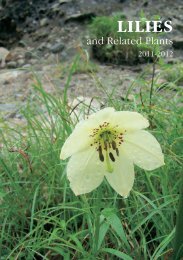LILIES - RHS Lily Group
LILIES - RHS Lily Group
LILIES - RHS Lily Group
Create successful ePaper yourself
Turn your PDF publications into a flip-book with our unique Google optimized e-Paper software.
for making of barragons, a genteel corded stuff, much in vogue at that time for<br />
summer wear; and chiefly manufactured at Alton, a neighbouring town, by some<br />
of the people called Quakers: but from circumstances this trade is at an end. The<br />
inhabitants enjoy a good share of health and longevity: and the parish swarms<br />
with children”.<br />
And some detail as to the inhabitants of the village: “Total of burials from 1720<br />
to 1779 both inclusive, 60 years - 640. Baptisms exceed burials by more them<br />
one-third. Baptisms of Males exceed Females by one-tenth, or one in ten. Burials<br />
of Females exceed Males by one in thirty. It appears that a child, born and bred<br />
in this parish, has an equal chance to live above forty years. Twins thirteen times,<br />
many of whom dying young have lessened the chance for life. Chances for life<br />
in men and women appear to be equal”.<br />
Gilbert White was born in Selborne, a north Hampshire village lying just a few<br />
miles to the southeast of Alton and about 50 miles to the southwest of London in<br />
southern England, in 1720. The White family moved away that year but returned<br />
in 1729 and Selborne remained White’s home until his death in 1793.<br />
Gilbert went up to Oriel College, Oxford in 1740. Five years earlier in 1735<br />
Carl Linnaeus the Swedish naturalist had suggested a new classification for living<br />
organisms. White became a Fellow of Oriel College in 1744, was ordained in<br />
1746 and became a curate. Ten years later in 1756 he was to become the Vicar<br />
at Moreton Pinkney in Northamptonshire but we have no record of his living<br />
permanently there.<br />
Five years earlier in 1751 White had started to keep records of activities in his<br />
garden and started writing the Garden Kalendar. Later writings included details<br />
of the flora in Selborne and the surrounding area in Flora Selborniensis.<br />
The Wakes and the Garden are a very special place. If I ever write the book<br />
“Britain’s Ten Most Beautiful Gardens” the Wakes will undoubtedly feature. The<br />
layout and style of the garden is so very attractive and the garden is beautifully<br />
maintained and the plants expertly grown. Add to this the backdrop of the beech<br />
woods and the Hanger and the Garden and House have that feeling of peace and<br />
tranquillity often so hard to find in today’s world.<br />
The garden has been restored to the layout and style of White’s time in<br />
the house. The “Six Quarters”, the “Basons” and the vegetable garden are all<br />
mentioned in White’s writings. He was of course a keen grower of vegetables<br />
and records of this are well documented. The haha so popular in gardens of the<br />
time features and a charming seat, the “Wine Pipe” overlooks the house from<br />
afar. This was constructed from a Portuguese brandy barrel!<br />
The beech woodlands called “the Hangers” form the backdrop to the house<br />
and garden. On Baker’s Hill just a short walk from the house Lilium martagon<br />
grows well and flowers every year in June. The current plants may well be<br />
99




